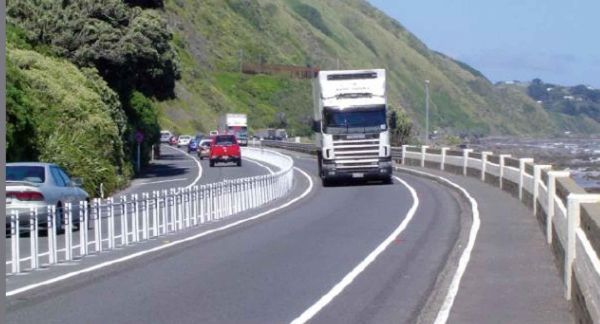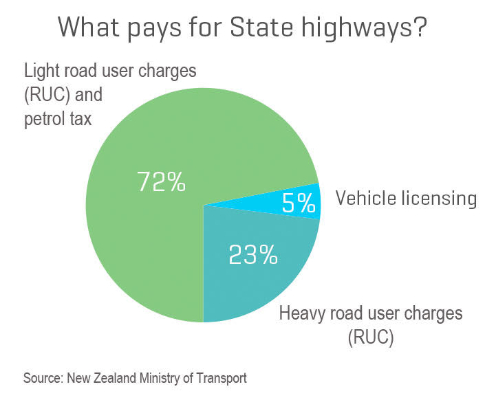Grand Highways Rob Funds Needed To Save Lives On Ordinary Roads

Politicians should stop promising grand highways and instead focus on upgrading New Zealand’s ‘third world’ roads, says the car review website dogandlemon.com.
Editor Clive Matthew-Wilson, who is an outspoken road safety campaigner, says:
“A 22-year-old man and a five-month-old baby died following a four-vehicle crash on State Highway 6 near Invercargill last Wednesday afternoon. It was the usual scenario: busy road, no median barrier and no roadside fencing. Someone made a mistake and now there are two more dead bodies.”
“According to credible studies, by simply fitting median barriers and roadside fencing to existing roads, reductions of up to 90% in death and serious injury can be achieved, with no evidence of increased road trauma for motorcyclists”.

“While the police continue to promote discredited theories on road safety, people continue to die. In fact, the very weekend after the police zero tolerance for speeding was widely publicised, eight people died on our roads.”
“Yet, on the same weekend, a drunk driver drove into a newly-installed median barrier between Waipukurau and Waipawa. No one was hurt, even though the road was crowded, Without the median barrier, someone would very likely have been killed.”
“The money that should be spent fixing the most dangerous roads in the country is instead often spent on a few new stretches of highway. New highways offer great convenience and safety, but only for short distances, because most new highways are extremely expensive and relatively short.”
Matthew-Wilson gave the example of the so-called ‘holiday highway’ that is gradually being expanded between Auckland and Whangarei.
“One tiny section – the Pūhoi to Warkworth highway (one of the previous government's seven Roads of National Significance) is going to cost upwards of $878 million, up from the original price of $710m.1. For $878 million, the government could have already installed median barriers, roadside fencing and roundabouts on all or most of the 160km of highway between Auckland and Whangarei2. So, the government’s luxury roads will bring convenience and safety for short stretches, while multiple people will die unnecessarily on the rest of the highway.”
Matthew-Wilson says the two biggest lobby groups for new highways are property developers and trucking companies.
“Property developers buy land near major cities for future developments. These developers then lobby politicians for highways that link nearby cities to these future developments. As soon as a highway is announced, the developers’ land goes up in value many times. So, the developers grow very rich from these new highways, but pay almost nothing towards the cost of building them.”
Matthew-Wilson claims that trucking companies also heavily lobby for new highways, but escape most of the costs of these new roads.

“Effectively, trucking companies grow rich off the backs of ordinary motorists.”3
Matthew-Wilson also claims that trucking companies lobby against life-saving roundabouts.
“Roundabouts can reduce fatal intersection collisions by 90%, yet they are relatively rare on highways in this country. Why? At least part of the reason is because trucking companies hate them; roundabouts slow trucks down, and slow trucks make less money.”
Matthew-Wilson acknowledges that some new highways need to be built for safety reasons.
“Some roads are simply too old and unsafe for modern conditions. And, in fantasy world with limitless funds, you could make a case for upgrading or replacing just about every road in New Zealand. You could also claim that these new roads were being built for safety reasons, even if they weren’t.”
“However, in the real world, funds are very limited. Priority should go to the projects that will save the most lives. If trucking companies and developers want new roads to make their lives easier, they should pay the true costs.4”
“The government doesn’t need to build grand new roads to save lives. Think of the Auckland harbour bridge: it used to have one serious or fatal crash a week. The police tried the usual speed enforcement campaigns, which made no difference. Eventually, a median barrier was installed on the harbour bridge; the serious crashes virtually stopped overnight and never came back.”
“What does that tell you? The politicians should stop offering grand highway schemes and instead should commit to saving lives on the roads we’re forced to use every day.”
1. The Pūhoi to Warkworth highway will make life easier for holiday-makers. It will also encourage individual motorists to commute the 160km between the two cities. However, the reality is, the main beneficiaries of the road will be the trucks that use it many times daily.
2. The government estimates that: "The cost of installing wire rope median barrier ranges from $80,000 to $100,000 per kilometre. However, when installing a median barrier there are often other works that are required to make this an effective treatment, these include road widening, moving of utilities, intersection improvements and provision of turning facilities. This takes the cost up to $2.5 million to $3 million per kilometre."
However, it is clear from multiple discussions with NZTA that the process of installing median barriers and roadside fencing is currently hopelessly slow and bureaucratic. For example, instead of seeing the Auckland to Whangarei highway as a single road, planners see it as a series of discrete sections of highway that need individual plans, individual approval, individual contracts and individual implementation. This process makes a relatively simple process into a long-winded and very expensive one.
Given the logistics required, many NZTA staff have consistently adopted the attitude that it’s too complicated to modify existing roads. So (for them), it’s so much simpler and easier if the government simply decides to build a new road. The problem with this attitude is that it costs billions and tends to delay vital safety upgrades for decades. Therefore, countless innocent people die unnecessarily.
3. Figures correct as of late 2018. We were unable to find the latest version of this graphic during a quick search of the current MOT website. Road user charges for diesel vehicles have gone up since this graphic was produced, but only slightly.
According to a reliable source close to the Ministry of Transport, about two thirds of the cost of building new highways goes to making them strong enough for large vehicles, which are mainly trucks. Excluding events such as storm damage, about 80% of all road maintenance costs are the result of the damage caused by trucks.
These figures have been publicly used by us before and have never been disputed by either the government or the trucking industry, which speaks for itself. To put it crudely, current road user charges cover the damage caused to the road surface by trucks, but not the remainder of costs associated with heavy vehicles. So, if the road were an iced cake, road user charges would cover the costs of icing but not the rest of the cake.
4. Toll roads don’t really solve the problem, because affordable tolls take many decades to pay the costs of new highways.
Public-private partnerships mean the government pays out less upfront but that the whole project costs far more in the longer term because the private partner has to make a profit, whereas the government doesn’t. Also, history has shown that public-private partnerships often go wrong, with the taxpayer almost inevitably paying the huge extra cost.
Clive Matthew-Wilson has been actively campaigning on road safety issues for 25 years. Mentored by engineer Chris Coxon (former technical chair and founding member of the Australian New Car Assessment Program – ANCAP), Matthew-Wilson was the first person to publish crash test results in New Zealand. His research into seatbelt upgrades was awarded by the Australian Police Journal. Matthew-Wilson is a strong supporter of pedestrians’ and cyclists’ rights and has helped shape many major road safety policies in New Zealand.
Clive Matthew-Wilson is equally distrustful of all politicians. He is not affiliated with the Taxpayers’ Union nor any similar body.
Suggested reading:
• Why fines and the threat of disqualification don’t work for the highest risk drivers.
• Why asking people to drive safely is an expensive waste of time.
• Why advanced driver and rider training has no effect on the road toll.
(The second and third link are the same document).


 Gordon Campbell: On bird flu, AUKUS entry fees and Cindy Lee
Gordon Campbell: On bird flu, AUKUS entry fees and Cindy Lee Susan Botting - Local Democracy Reporter: Ruawai Leader Slams Kaipara Council In Battle Over $400k Property
Susan Botting - Local Democracy Reporter: Ruawai Leader Slams Kaipara Council In Battle Over $400k Property Te Pati Maori: Another ‘Stolen Generation’ Enabled By Court Ruling On Waitangi Tribunal Summons
Te Pati Maori: Another ‘Stolen Generation’ Enabled By Court Ruling On Waitangi Tribunal Summons Peace Action Wellington: Die In for Palestine Marks ANZAC day
Peace Action Wellington: Die In for Palestine Marks ANZAC day Labour Party: Penny Drops – But What About Seymour And Peters?
Labour Party: Penny Drops – But What About Seymour And Peters? Government: PM Announces Changes To Portfolios
Government: PM Announces Changes To Portfolios Family First: Just 1 In 6 Oppose ‘Three Strikes’ - Poll
Family First: Just 1 In 6 Oppose ‘Three Strikes’ - Poll


